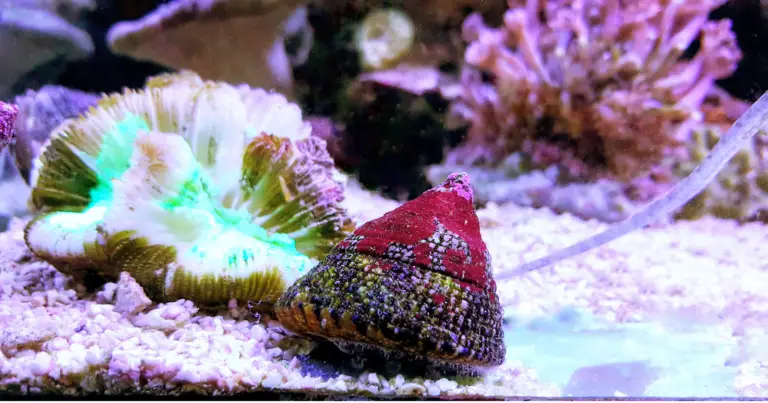How Often Do Mystery Snails Lay Eggs?
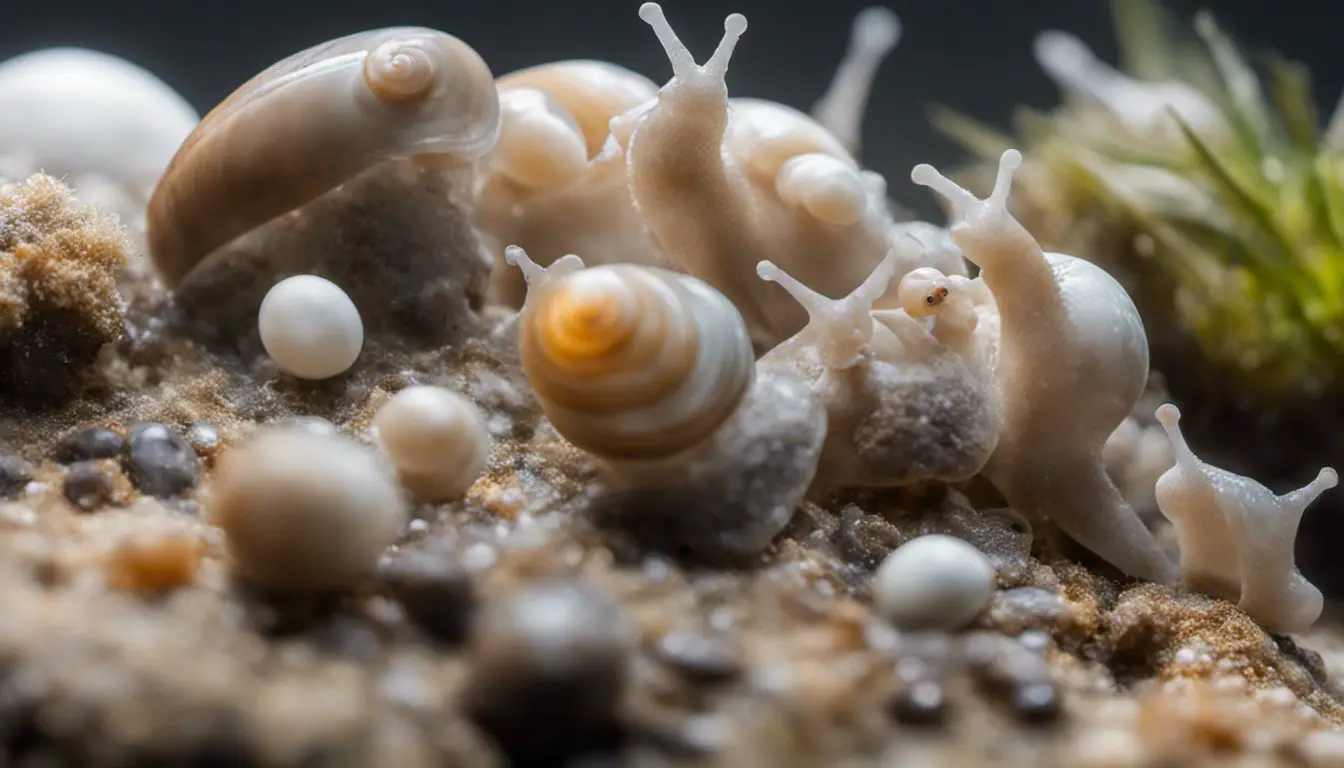
Mystery snails are fascinating creatures that can add beauty and tranquility to your aquarium. As a mystery snail owner, you may be curious to know how often mystery snails lay eggs and what it means for the population of snails in your tank.

Mystery snails lay eggs quite frequently, producing many clutches throughout the year. The egg-laying frequency can be influenced by factors such as water quality, temperature, and food availability. On average, a clutch of mystery snail eggs takes around two to four weeks to hatch, depending on the conditions in your aquarium.
Keeping an eye on egg production can help you manage the snail population in your aquarium and ensure a balanced and healthy ecosystem. By understanding their breeding habits and providing the right environment, you can enjoy the beauty of these captivating creatures while maintaining a thriving aquatic community.
Contents
Table of Contents
Understanding Mystery Snails

Mystery snails are popular freshwater snails known for their unique appearance and vibrant colors. They are a type of apple snail, including the spike-topped apple snail. Native to South America, their highest density can be found in countries such as Peru, Paraguay, Brazil, and Bolivia source.
The growth and size of a mystery snail can vary depending on the specific subspecies. However, they are generally considered a larger type of snail than others. Their shell can reach up to 2 inches in diameter, allowing them to stand out in your aquarium source.
One intriguing aspect of mystery snails is their variety of colors. They are in gold, blue, purple, and black shades. This diverse range of colors adds to their appeal and makes them a favorite among aquarist sources. Their appearance also includes a distinctive, triangular shell, quite different from the typical round shape associated with most snails.
Mystery snails are scavengers, and their diet consists mostly of plant matter. As an aquarium owner, you can provide spinach as a healthy and nutritious food source for your mystery snails. This leafy green vegetable offers key nutrients supporting their growth and health.
Mystery Snail Reproduction

Mystery snails are popular among aquarists because they clean aquariums by eating algae and other waste materials. For them to reproduce, there needs to be both male and female mystery snails in the tank. They are not hermaphrodites, which means they cannot reproduce without a partner of the opposite sex.
When it comes to mating, the male mystery snail will attach itself to the female and transfer sperm to her through their penis sheath. Mating can occur frequently, as male snails are prone to copulation and may even mistakenly attempt to mate with other males during a single mating session.
After successful copulation between a male and female mystery snail, the female will lay eggs in clutches. The number of clutches produced can be affected by various factors, such as temperature, water quality, and the availability of food sources. It is common for females to lay multiple eggs over a short period, making mystery snail breeding a relatively quick process.
Creating a favorable environment for your mystery snails is important to encourage successful breeding. This includes maintaining a water temperature between 73℉ and 78℉, providing ample space for them to move and explore, and offering a range of nutritious food options to support their health and reproductive capabilities.
In conclusion, understanding the reproductive process and specific requirements of mystery snails enables you to breed them in your aquarium successfully. With a little attention to their environment and care, you can facilitate regular mating and the production of healthy clutches of eggs, ensuring a thriving population of these unique creatures in your ecosystem.
Egg-Laying Behavior and Frequency

Mystery snails are known for their unique egg-laying habits. They lay eggs in clutches, clusters above your aquarium’s waterline. Understanding your mystery snails’ egg-laying frequency and behavior is critical as an aquarist.
Typically, mystery snails lay eggs once they reach maturity, around 3-4 months of age. They can reproduce frequently throughout their lifetime, which spans about one year. To provide a suitable environment for egg-laying, maintain the water temperature around 72°F (22°C) and ensure the tank has adequate oxygen levels for snail survival.
Once a mystery snail starts laying eggs, it’s common for them to lay at least four eggs in their lifetime. These clutches can take hours to days to appear; in some cases, they may lay one clutch after another back-to-back. The interval between egg clutches varies, but it’s typically between 3-4 weeks, assuming they are healthy and cared for.
Each egg clutch can contain hundreds of eggs, but don’t be alarmed—not every egg will hatch into a baby snail. Only about 30-70 of the eggs are likely to hatch if the conditions in your tank are optimal. Proper care for your mystery snail eggs involves keeping them moist by maintaining optimal water levels and ensuring the area is not overly chlorinated to avoid killing the developing snails.
In summary, your mystery snail’s ability to lay eggs depends on age, health, and environmental conditions. A clean, stable, and nurturing environment will ensure successful egg-laying and increase the likelihood of your snails producing multiple healthy clutches.
Conditions for egg-laying
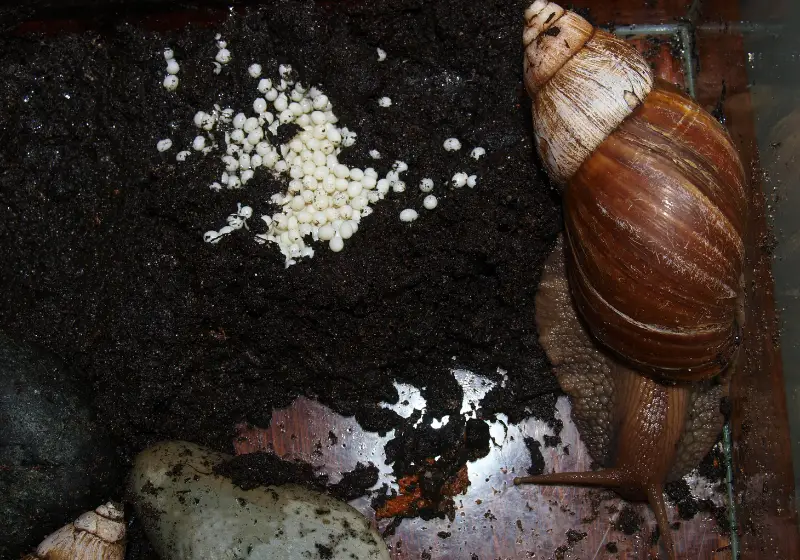
When setting up an aquarium for your mystery snails to lay eggs, it’s essential to create optimal conditions to ensure their health and successful reproduction. Here are some crucial factors to consider:
Water Parameters: Maintaining appropriate water parameters is vital for your mystery snails’ well-being. The ideal pH level for your aquarium should be between 7.0 to 7.5. Regularly test the water and make necessary adjustments to maintain this range.
Temperature: The water temperature plays a significant role in encouraging mystery snails to breed. Keep the water temperature between 73℉ and 78℉ for best results. Using a tank heater helps regulate the temperature; increase it by 1 degree every 2 days until you reach the desired range.
Water Level: Mystery snails tend to lay their eggs above the waterline. Ensure enough space between the water level and the aquarium’s lid. Lower the water level by a few inches to provide a safe and comfortable environment for egg-laying.
Calcium: Calcium is essential for a mystery snail’s shell’s health and development. Supplement your snail’s diet with calcium-rich food, or add calcium-based items like cuttlebone in their aquarium.
Humidity: Keep the humidity around the breeding tank stable to prevent the eggs from drying. A tight-fitting lid with ventilation holes can help maintain a moist environment.
Breeding Tank: Setting up a separate breeding tank can be beneficial for controlling the conditions and ensuring adequate space and privacy for your mystery snails while breeding. Transfer the snails to this tank and provide them with abundant food, making them more comfortable laying eggs. The breeding tank should also have ample hiding spots and surfaces for the snails to lay their eggs on.
By monitoring and adjusting these factors accordingly, you can create the ideal environment for your mystery snails to lay eggs and thrive in your aquarium.
Egg Clutches and Hatching
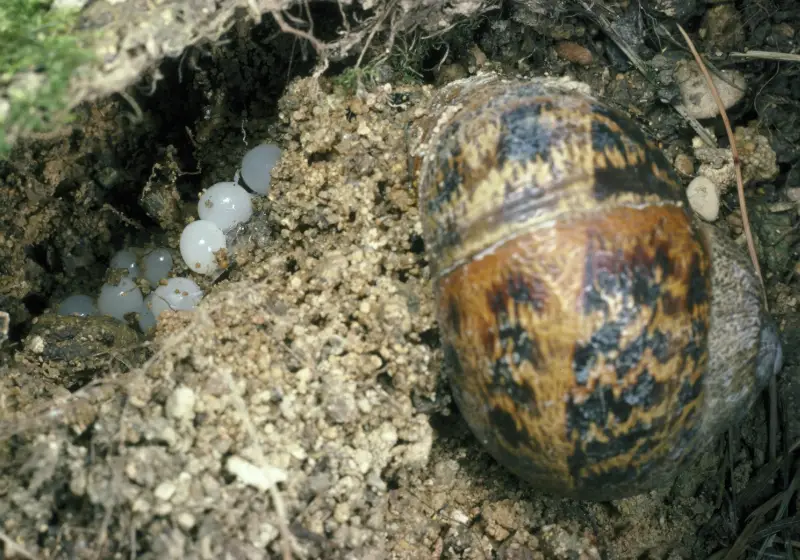
Mystery snails typically lay egg clutches above the waterline, which can contain around 400 eggs, depending on various factors. Maintaining optimum humidity within the tank is essential to support healthy egg development. You can mist the eggs daily to keep them moist.
Newly laid mystery snail eggs are soft and have a milky appearance. Within a few hours, they will darken and harden. The hatching process can take anywhere between 2-4 weeks. Be patient and monitor the egg clutches during this time. If they don’t hatch within this period, it is advisable to discard them.
As the eggs hatch, you’ll notice baby snails emerging. These tiny creatures are mostly self-sufficient and can take care of themselves. However, paying attention to potential predatory species in the tank is important. Baby snails are vulnerable to fish, bottom feeders, and shrimp. You might want to consider separating them from these threats if necessary.
Females can lay multiple clutches of eggs even without recent mating, as they can hold sperm for at least 9 months. It’s crucial to be able to differentiate between fertilized and unfertilized eggs. Viable eggs will darken and harden after they are laid out, while unfertilized eggs will remain soft and may have an unpleasant smell. Remove any such eggs to keep the environment clean and healthy for the rest of the inhabitants.
If you have a surplus of baby snails once they hatch, consider selling them to fellow aquatic enthusiasts. This can help control the snail population in your tank and provide others with the joy of owning these fascinating creatures.
How to Care for Mystery Snails & Hatch Their Eggs
Feeding and Care of Baby Snails
Feeding and caring for baby mystery snails is crucial for their growth and overall health. Baby snails have the same dietary requirements as adult snails, which mainly involve a diet of vegetables, algae, and other sources of calcium and protein.
It’s important to provide a variety of vegetables for your baby snails, such as lettuce, spinach, and cucumber. This will ensure they get the nutrients they need for their growth and development. You can also supplement their diet with algae wafers to provide them with additional sources of protein and calcium.
Calcium is essential for building strong shells in mystery snails. You can provide adequate calcium by adding cuttlebone, crushed eggshells, or calcium supplements to the water. It’s important to monitor the calcium levels in the water to prevent shell deterioration.
In addition to their main diet, baby snails will also benefit from adding protein. Protein is essential for their growth and development and can be provided through high-quality fish food pellets or other protein-rich snail foods. Break the pellets into small pieces before feeding them to your baby snails.
Remember to clean their tank regularly, as baby snails produce much waste. Also, maintain the water quality and ensure it stays clean to encourage healthy growth in your snails.
Regularly monitor the water temperature and ensure it stays within the recommended range for mystery snails. A stable temperature will help your snails thrive and grow without any issues.
Following these guidelines, you can create a nurturing environment for your baby mystery snails, allowing them to grow into healthy adults.
Keeping Mystery Snails in Community Tanks

Mystery snails are a popular choice for community tanks due to their peaceful nature, easy care, and ability to help clean the aquarium by eating algae. As a hobbyist, understanding how to keep mystery snails in community tanks is essential to maintaining a harmonious and healthy environment for aquatic pets.
First and foremost, ensure that your community tank has the appropriate water conditions for mystery snails. They thrive in freshwater environments with a pH of around 7.0 to 7.5 and temperatures between 68 to 82 degrees Fahrenheit. Regularly monitor your aquarium’s water quality to keep your mystery snails and their tank mates healthy.
Regarding tank size, you may consider having at least a 10-gallon aquarium, as mystery snails can grow relatively large. This will provide ample space for these freshwater snails to move around and comfortably coexist with other community species. Keeping 2-4 mystery snails in a 10-gallon tank is recommended to avoid overcrowding.
When it comes to tank mates, mystery snails are compatible with a variety of community species. They can coexist peacefully with non-aggressive fish such as tetras, guppies, mollies, and other invertebrates like shrimp.
However, be cautious when introducing larger or more aggressive fish species, as they may see your mystery snails as a potential meal. Planning your community carefully will help ensure a safe environment for your snails.
Mystery snails are known to lay eggs once or twice a month. Female snails lay eggs above the ground or at the water’s surface, making it easy to spot and remove them if breeding is not your goal. Providing the snails with adequate space above the waterline for their egg-laying habits is crucial.
To promote their algae-eating abilities and maintain a clean tank, provide your mystery snails with smooth surfaces like glass or flat rocks. This encourages their natural grazing behavior and contributes to the overall cleanliness of your aquarium.
While mystery snails can survive on the tank’s algae and decaying plant matter, they appreciate supplementary feedings. Offer blanched vegetables, sinking pellets, or algae wafers to meet their dietary needs.
Following these guidelines and maintaining the proper environment, you can confidently keep mystery snails in your community tank and enjoy their beneficial contributions to your aquarium hobby.
Common Concerns About Mystery Snails
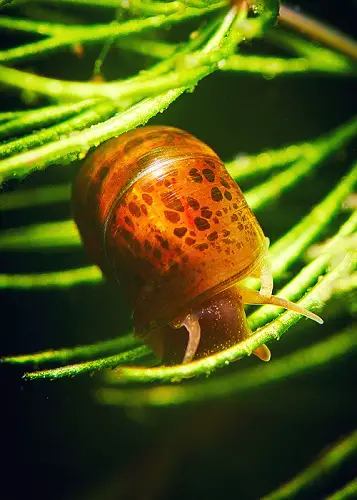
One of the most important questions for mystery snail owners is how frequently their snails lay eggs. It’s important to understand that mystery snails can mate multiple times and store sperm for future egg fertilization. This means that a single mating session can produce several clutches of eggs over time.
You might notice your mystery snail eggs appearing frequently or occasionally, depending on the individual snail and the conditions in your aquarium. Proper care and a suitable environment can influence your snail’s reproductive habits. If you don’t want your mystery snails to overpopulate your tank, you can choose to keep or discard the eggs.
Another common concern is whether your mystery snail eggs are fertile or not. Determining the fertility of mystery snail eggs can be difficult, as they can produce and lay infertile clutches if they haven’t mated (AG). Keep an eye on the development of the eggs to get an idea of their viability.
Mystery snails have unique physical features, such as their tentacles and gills, which can raise questions about their health. Observing the behavior and appearance of your mystery snails can help identify any issues or abnormalities. If their tentacles or gills seem damaged or not functioning properly, it might indicate poor water quality or stress in the snail.
Waste management is essential to maintaining a healthy aquarium for your mystery snails. Ensure you clean your tank regularly and remove uneaten food to prevent poor water quality and possible snail health issues. Dead mystery snails should be removed promptly, as they can quickly decompose and affect water quality.
In conclusion, understanding your mystery snails’ reproductive habits, physical features, and health is crucial to their well-being. By monitoring their egg-laying frequency, tentacles, gills, and waste management, you can anticipate potential issues and create a thriving environment for your aquatic pets.
FAQs: How Often Do Mystery Snails Lay Eggs
How frequently do mystery snails produce eggs? How often do mystery snails lay eggs?
Mystery snails can lay eggs several times, usually in intervals of a few weeks. The frequency may vary based on factors such as the snail’s age, health, and tank conditions.
What is the appearance of mystery snail eggs?
Mystery snail eggs are usually laid in a pink or ivory-colored mass above the water surface. Each egg clutch can contain multiple individual eggs arranged in a grid-like pattern.
Do fish consume mystery snail eggs?
Yes, fish and other water inhabitants may consume mystery snail eggs in the wild. This is why the female snail lays the eggs above the water surface, which helps protect them from predation (source).
How many eggs can a mystery snail lay at once?
A mystery snail can lay several hundred eggs in a single clutch. However, it’s important to note that not all eggs will hatch successfully. Factors like water temperature, humidity, and egg health can impact the hatching rate.
What is the hatching process for mystery snail eggs?
The development and hatching process begins after the female snail lays her eggs. The eggs require a certain level of humidity and warmth to hatch successfully. If the conditions are right, the eggs will darken, and baby snails will eventually emerge from the clutch.
How long before mystery snail eggs hatch?
The hatching process for mystery snail eggs usually takes between 3 to 4 weeks. The exact duration can vary depending on factors like temperature, humidity, and the health of the eggs (source).






